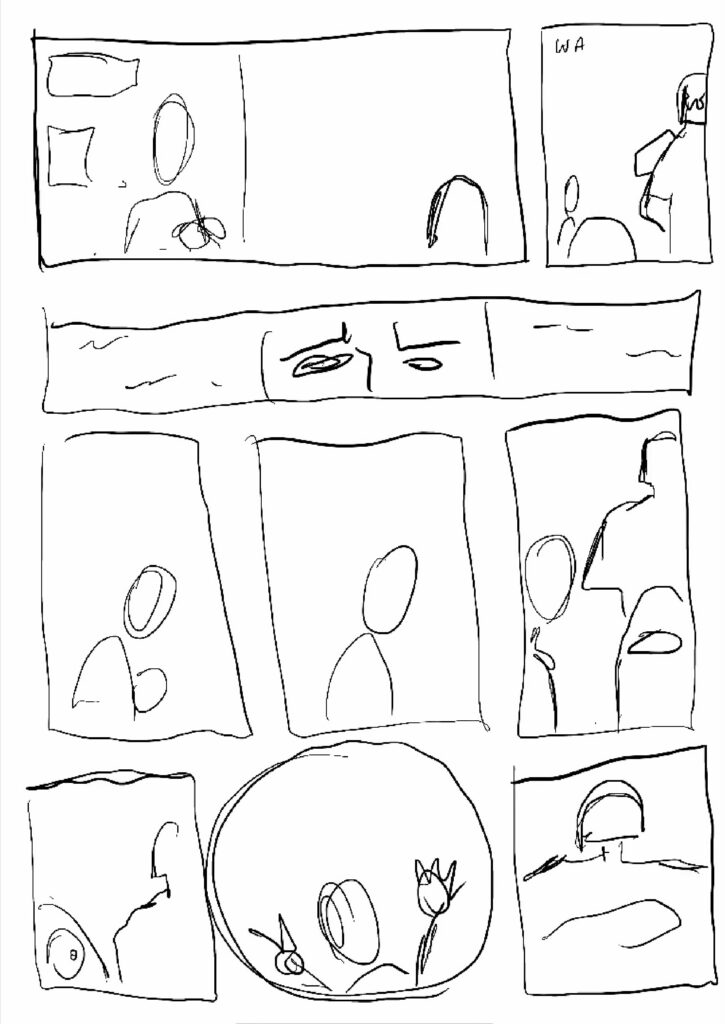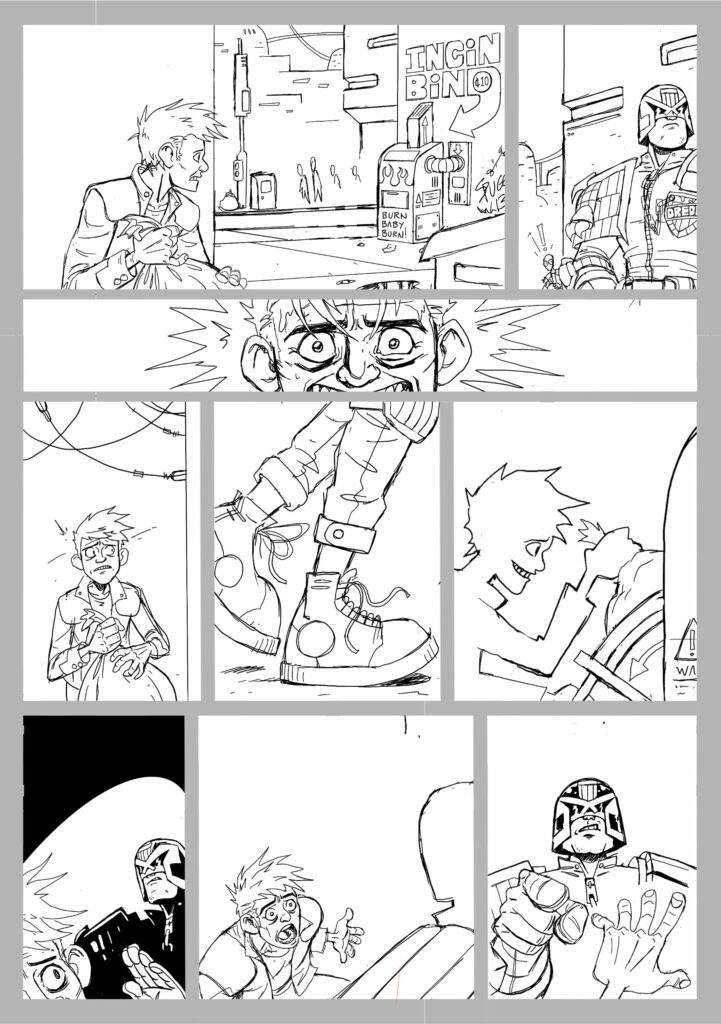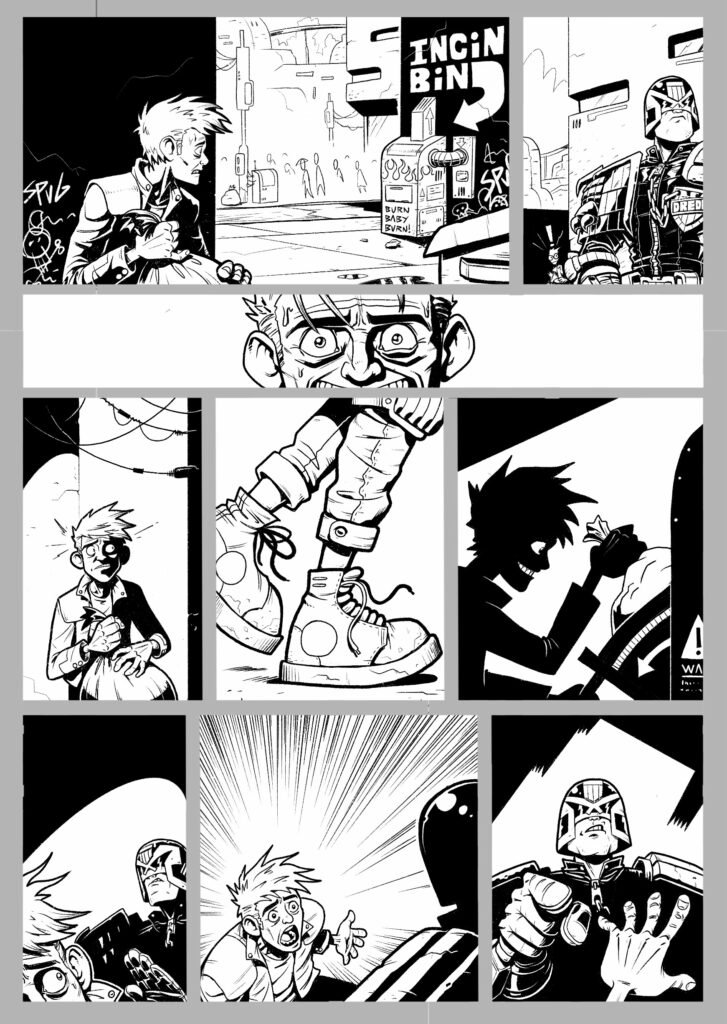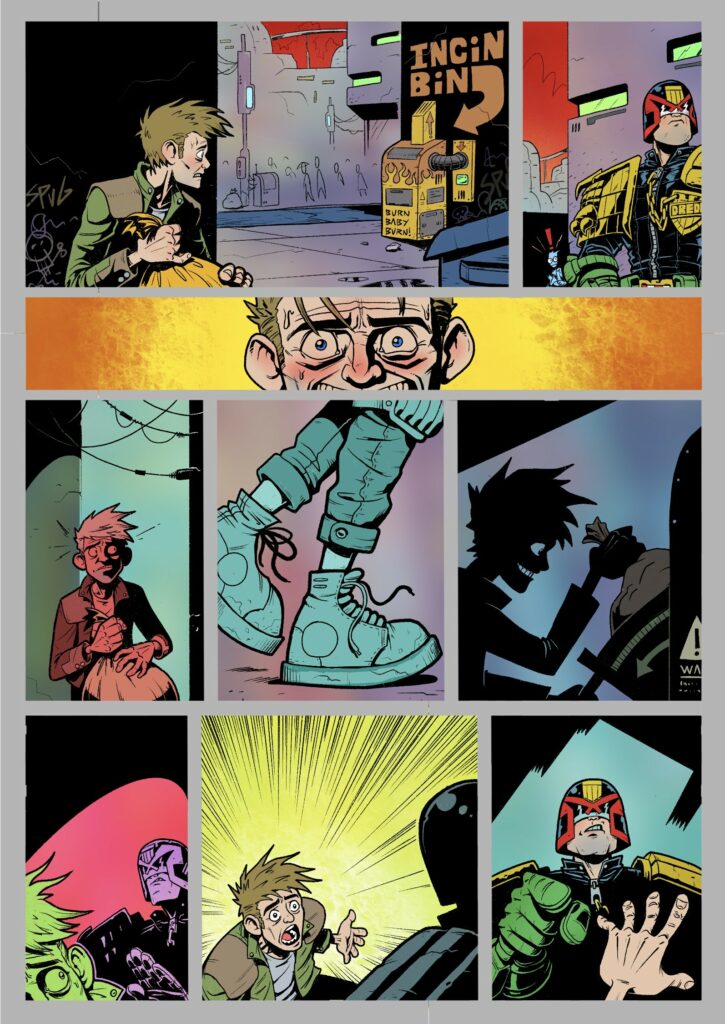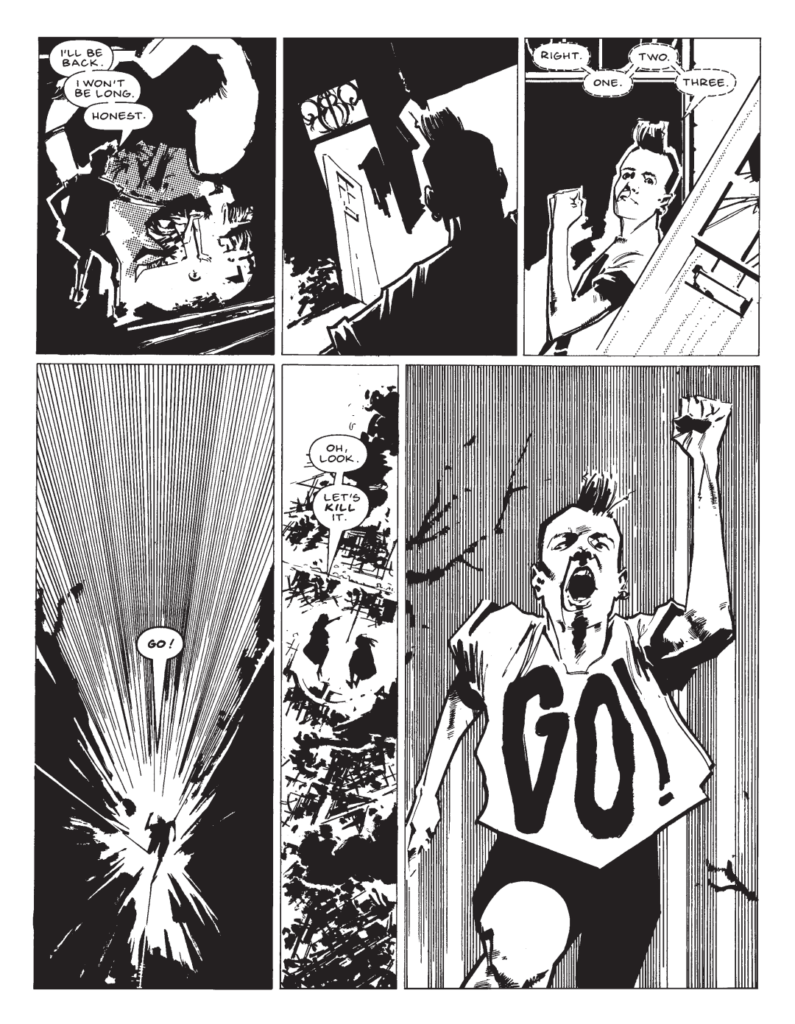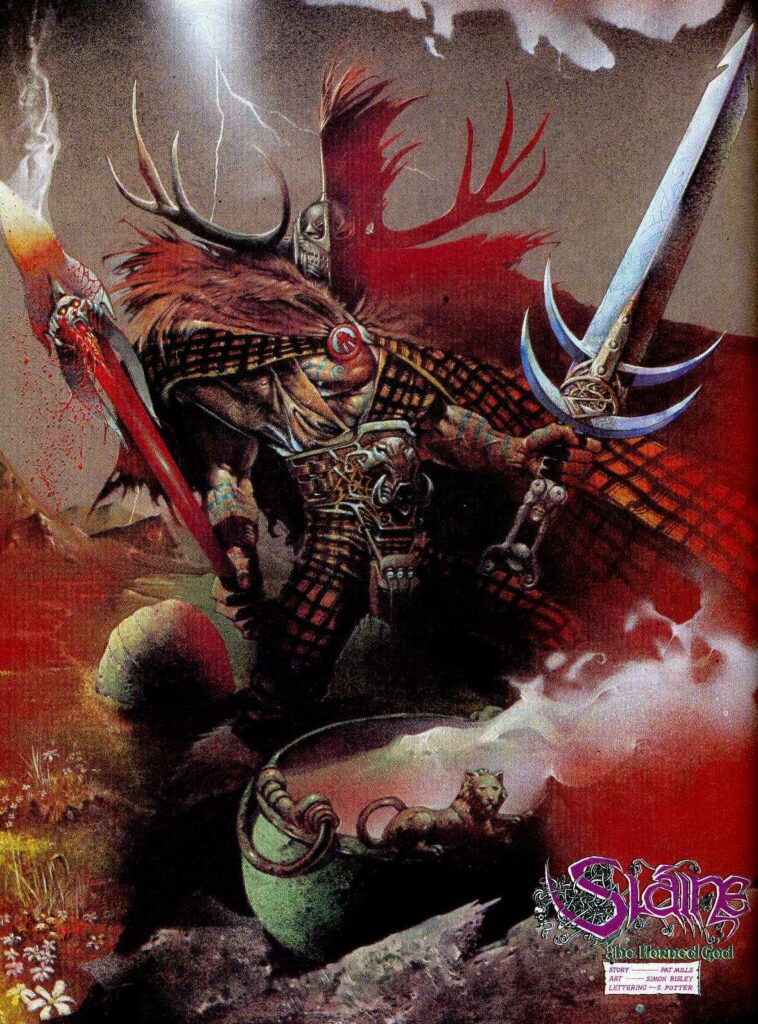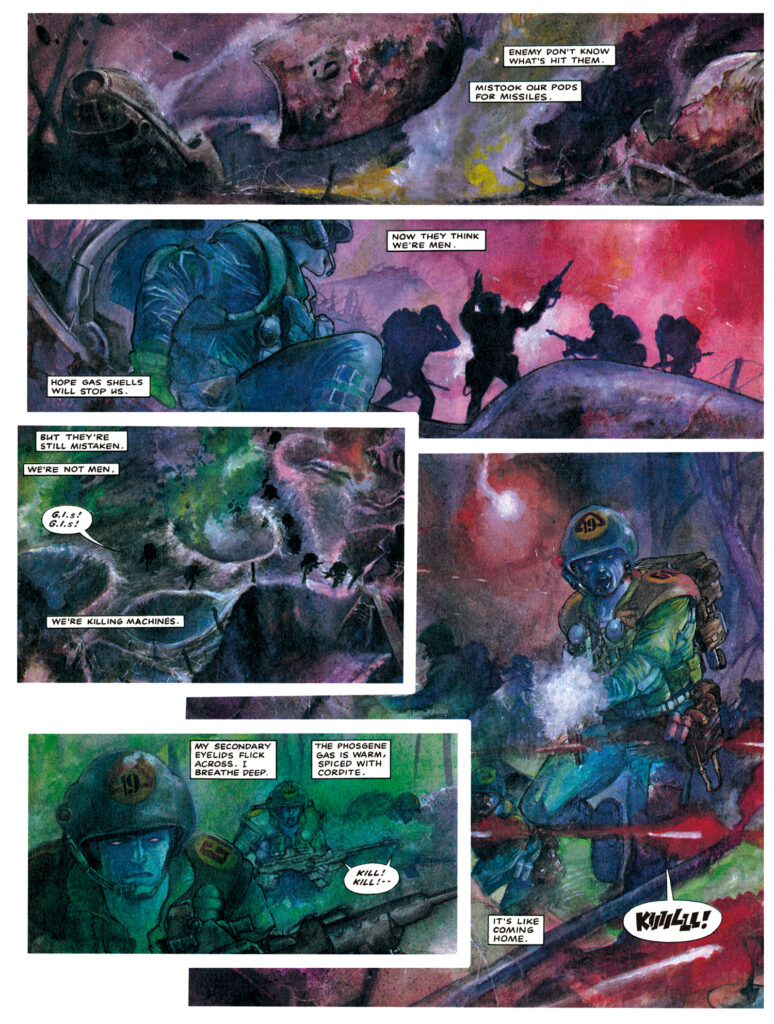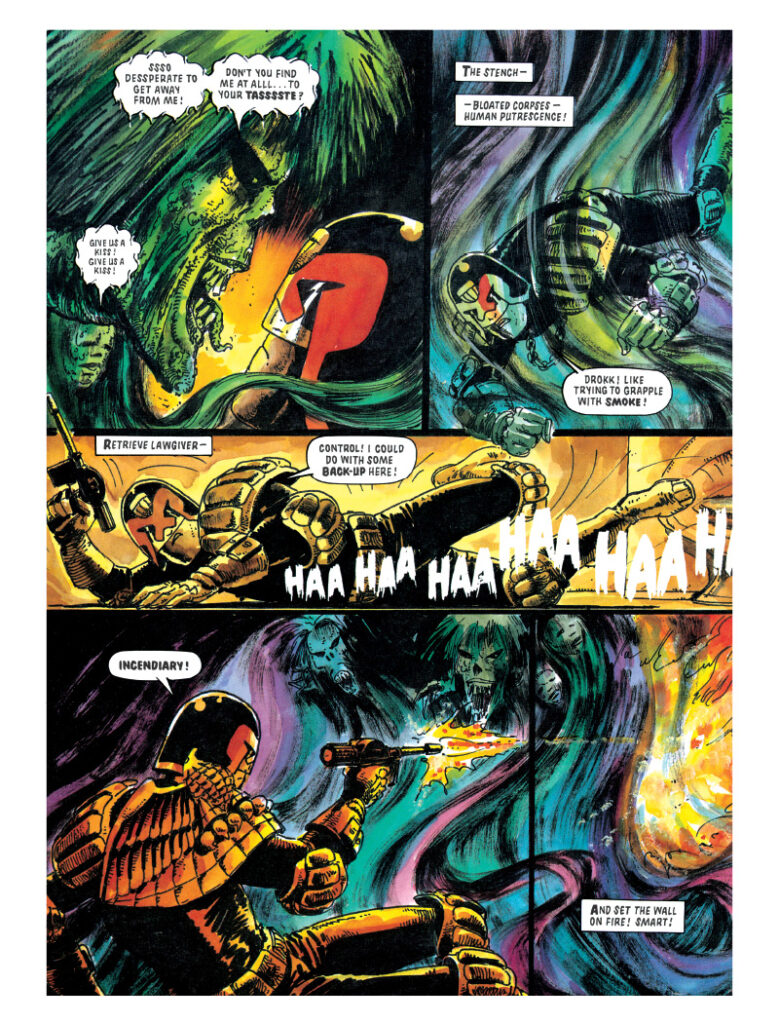2000 AD Art Stars winner talks their ultimate one-page Judge Dredd story, ‘The Telltale Incin Bin’
16th June 2023
2000 AD Art Stars is the competition that catapults new creators into the pages of the Galaxy’s Greatest Comic – and the latest round has just seen another new droid annointed by Tharg the Mighty – Alan Kerr.
Alan’s one-page Judge Dredd tale, The Telltale Incin Bin, was chosen from a record numbers of entries and now the dust has settled it’s time to chat…
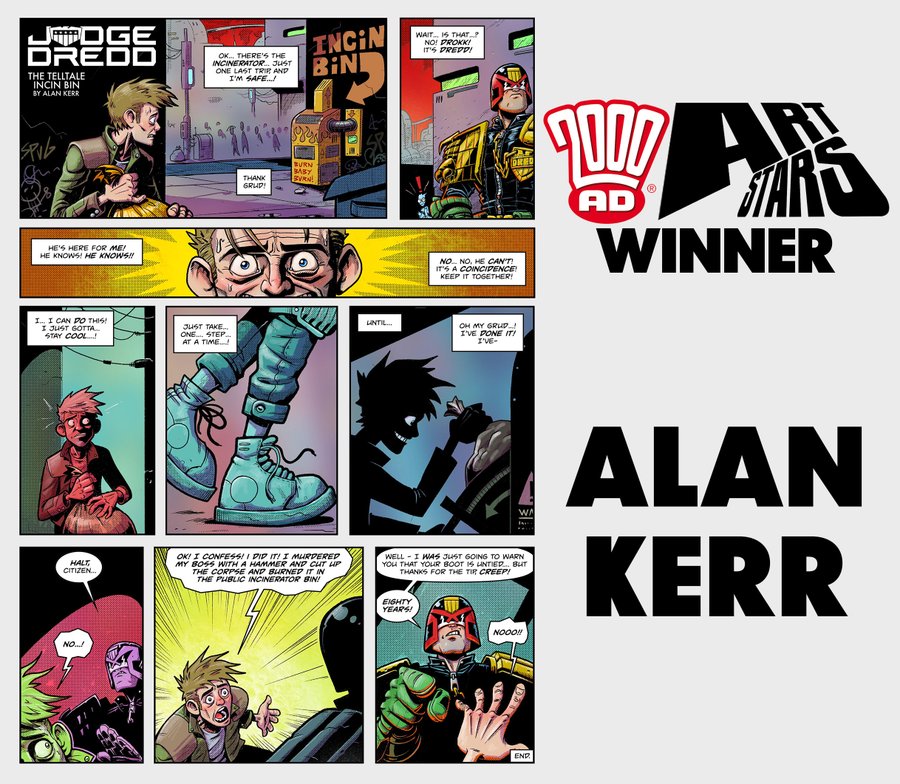
As a way to mark the end of 2000 AD’s 45th-anniversary celebrations, Art Stars was switched up from pin-up images to the way more difficult theme of making the ultimate one-page Judge Dredd story!
More than 300 worthy entries flooded in but, in the end there can only be one winner chosen by Tharg the Mighty… and that was Alan! As a winner of 2000 AD Art Stars, Alan gets paid and will see his strip in a future Prog. So here’s the strip in full for you to enjoy and after that, a chat with Alan about what it means to win…

Alan, let’s start with a quick reaction to you winning Art Stars this time round – as the latest winner of the 2000 AD Art Stars contest… how does it feel?
ALAN KERR: Zarjaz.
Always the correct answer!
AK: I honestly didn’t think there was any real chance of me winning, so it’s an awesome surprise, on top of being very exciting. 2000 AD means a lot to me.
Thing is, it was a very different contest this time around -where previously it had been just a single pin-up image, this latest was a far tougher prospect – the one-page Judge Dredd tale.
Now, as anyone who’s ever had to sit down and contemplate a Future Shock will tell you, getting something done in full – beginning, middle, end – in just 5 pages is hard as hell. But to be able to write and draw a single-page Dredd story – well, how hard is that?
So, where did the germ of the idea come from with The Telltale Incin Bin? Was it something you’d been sitting on for a while or was it something thought up specifically for this Art Stars?
AK: It was weirdly straightforward, to be honest – something this compressed had so many constraints, it almost forced me into this story.
I always remember some writing advice, that the easiest way to build a story is to just make a character want something – and then add a complication.
This story needed to be really simple, so I tried to think of the simplest thing that a character could want – and crossing the road (to get to the other side) seemed like a funny idea. Dredd was the obvious complication! The whole page just fell into my head after that.

It seems to me – although I have no influence over Tharg’s choices in these matters – that a lot of the reason you won was because your strip had that classic mix found in Dredd over the years; that ever-present threat of being found out, the panic all Cits feel when confronted with the Law – whether or not they’re trying to get rid of a body, but most of all that sense of wonderful ridiculousness that runs through those great Dredds. I think all that’s right there in your one-pager.
AK: That’s very flattering, thank you. It was important to me that Dredd wasn’t the actual protagonist of the story – the best Dredd strips are usually about life in Mega-City One, not supercops with big guns.
As far as the artwork goes, it’s another bit of classic Dredd, using exaggerated facial expressions to tell so much – a perfect example of show don’t tell going on as you’re letting the artwork do a lot of the heavy lifting in the storytelling.
AK: I’d like to take credit for this clever decision, but it’s just how I draw. I can’t help it.

You also stuck determinedly to a rigid grid structure, eschewing the temptation to go very splashy or push boundaries with the art – again, keeping to the old ‘keep it simple stupid’ adage. Where simple here means just tell the story, get the essentials over, show don’t tell, and use the art to tell us about character and emotion.
AK: That was a difficult decision, because the classic UK comic page doesn’t use hard gutters like this – but I thought something this compressed really needed the storytelling clarity of a clear grid. Also, Mike Mignola says that clean gutters make comics more readable, and I think we can assume that anything Mignola says about comic art is correct.
Yep, definitely!
And of course, there’s a nice pair of boots in there. Maybe not MacMahon Dredd boots, but boots nonetheless – and another great bit of show don’t tell with the laces in that panel.
AK: Don’t forget the hint of classic Mega City kneepads too! I was embarrassingly pleased with the idea of hiding the untied lace in plain sight, behind the “step by step” line, I’m glad it’s being noticed.

Finally, the last panel gives us another bit of classic Dredd storytelling, the twist ending. Something that’s been done so many times and something you nailed so well here.
AK: Thanks! I agonised over the wording here. Would Dredd really take the time to tell a citizen their lace was untied? In the end I decided anyone as uptight as Dredd couldn’t help themselves. He’d straighten every wonky picture he saw.
What do you think it was about The Telltale Incin Bin that made it to the top of a rather large pile of entries and won Tharg’s approval here?
AK: I can’t say, some of the other entries I’ve seen were superb. The Mighty One moves in mysterious ways, after all. Who am I to question His will?
With an attitude like that, you should go far with Tharg!
Speaking of Art Stars, had you entered before now, when it was a pin-up competition?
AK: No, I never thought my stuff would stand out in a pinup competition, there’s too many amazing artists out there. I’m more of a nuts and bolts storyteller than a splash page artist.
I know we opened with the question, but let’s go a little bit more into what it meant to you to win this Art Stars. Are we into dream come true territory here?
AK: Absolutely, a literal childhood dream. It’s hard to really describe how big 2000 AD was to me as a kid. I always dreamed of getting something in the prog, but writing AND drawing? DREDD? As my first strip!? Come on. Ridiculous.

It’s unusual in many ways, the one page format, but it’s also unusual in that it calls for a good writer/artist, something that’s a rarity at 2000 AD. If/when you get to take things further, would you specialise at all – are you more a writer that draws or an artist who writes? Or would you consider yourself just a comic maker?
AK: I’ve never really thought about the distinction, I just do whatever it takes to get the ideas out of my head. I’d love to do both, but if I were to take it more seriously, writing would probably be more likely to fit into my life, because drawing full comic pages takes a LONG time. But who knows?
How old are you and when did you first get into 2000 AD? Was it a childhood thing – ‘my dad had a pile of them and I borrowed them’ sort of thing? Or was it something you got into later in life?
AK: I am, unpleasantly, 43.
Well hello fellow eldster!
AK: I was around 8 or 9 when 2000 AD hit me, I think. My older brother got me hooked – I can even remember the exact moment! He pulled me over to show me a Prog in the supermarket, and it was THAT Bisley drawing of Joe Pineapples shooting his rifle, in The Black Hole strip. I was obsessed immediately. I remember drawing nothing but robots with giant guns for months afterwards.
Congrats to that brother – serving Tharg well there!
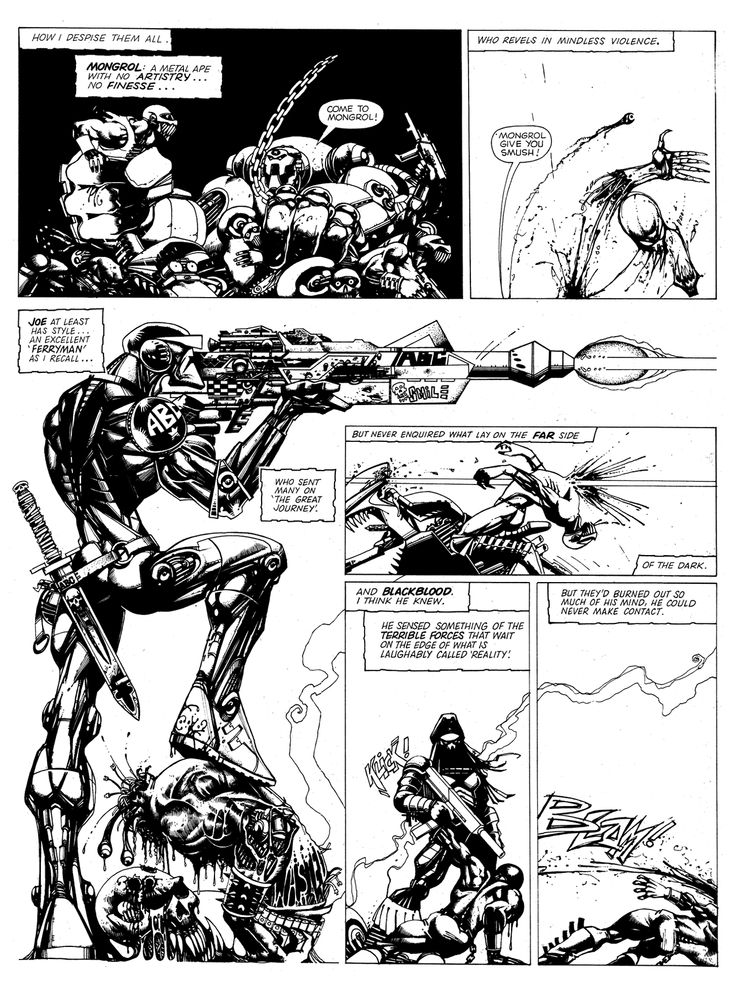
From ABC Warriors: The Black Hole – art by, of course, Simon Bisley
AK: I should also mention the important part my parents played at this early stage, by not paying too much attention to what was actually in the Prog. I think that when my mum realised just how many exploding heads my brother and I were seeing on a weekly basis, it was quite a shock.
And congrats to Mum and Dad for supporting your choice of reading!
What strips/artists/writers were your favourites and what inspired you from 2000 AD and those creators to go about making your own comics? I’m guessing Alan Grant because of your connection with him in comics? (And frankly, because, hey, it’s Alan Grant!) I can also see you’ve done a pretty cool Nemesis on your Instagram – so Kev O’Neill as well?
AK: 2000 AD at that time had such an insane embarrassment of riches, it’s hard to know where to start. We also had the Best of 2000 AD monthly, which introduced me to a lot of classic content at the same time.
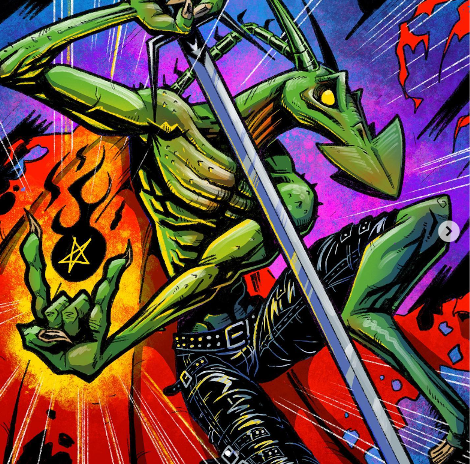
AK: So, sorry for the boring giant list, but some strips that immediately leap to mind from those early days are – The Horned God (obviously), Bryan Talbot era Nemesis, Zenith Phase 3 (for some reason no one ever seems to talk about Steve Yeowell’s incredible stylisation in this phase, but for me it’s some of the best comic art of all time), Song of the Surfer, Ace Trucking Co. (it’s easy to remember Ace as just silly comedy fluff, but the casual, throwaway world building in the strip is incredible), Strontium Dog (mid-era SD feels so effortless), Necropolis (I could talk about Ezquerra’s seedy neon colours in this for hours – you can see the influence in my Dredd page), the madness of Revere, and… Rogue Trooper: War Machine, which I still think is one of the best strips 2000 AD has ever made. Controversial, I know. Don’t @ me.
That’s just from the early days, of course. I could go on…!
Steve Yeowell on Zentih Phase III, Simon Bisley on Slaine The Horned God,
Will Simpson’s Rogue Trooper: War Machine, and the ‘seedy neon colours’ of Carlos Ezquerra’s Necropolis
.
The prize for winning is the chance to see your one-pager in a future 2000 AD – what are your thoughts on that?
AK: It’s amazing. Even if it’s just a competition win… it’s there! I am part of the canon, that’s the rules and no one can tell me otherwise. Even if I’m not, really.
You’re in the Prog, you’re part of 2000 AD and Dredd now!
So, we know about your 2000 AD history, but what about you more generally? The ‘about’ bit on your website gives us this… ‘Alan is an illustrator, comic creator and 3D artist. He currently works as an artist in the computer games industry, in Scotland.’ But that’s a little bit light… tell us all about yourself!
AK: Well, I’m a full time games artist. Does that count as leaving the day job behind? I used to be an industrial engineer fixing sewage pumps, so in my head it really does.
All the illustration stuff is really just hobby work now, although I was briefly a freelance illustrator full-time in the past.
The comics are more like a compulsion than a hobby. I haven’t actually been trying to get published, or even particularly noticed online, for a long time now – but the urge to make the stories doesn’t seem to go away. To be honest, I started to enjoy it a lot more when I just made them for fun, and stopped trying to get anyone to read them. That’s a full time job in itself.
I can see on your website that you’ve been published before this Judge Dredd, with Kreepy Kat in several magazines and Lusi Sulfura published in the Wasted comic anthology created and published by Alan Grant. Which explains why, when I saw your name and your art, I was sure I’d seen something from you before!
Is that the extent of what you’ve had published so far?
AK: I think so? It’s hard to remember everything I’ve churned out at this point, and what it was for!
From seeing your work online I’ve enjoyed the various pieces to read on your website. There’s No-Man, Tombworld, World Without End, Amy Excalibur, Skull Hunters, Jenny Spider Freak Fighter, Jack Dragon, and the aforementioned Kreepy Kat.
Kreepy Kat is the old school style webcomic of the lot, the four panel square grid of gags from 2017 – unless I’m mistaken? But how old are the rest of these works and in what order did you do them?
AK: Kreepy Kat and Lusi Sulfura were from around the same time, around 2005-2010-ish. Everything else is much later, from the last 5-7 years or so. For some reason the urge to make comics went away in between. It was quite relaxing, to be honest. Now the ideas won’t leave me alone, again.
I’d definitely recommend anyone who enjoyed what you did with the Judge Dredd one-pager to go and read them all, as there’s plenty of great comic making there.
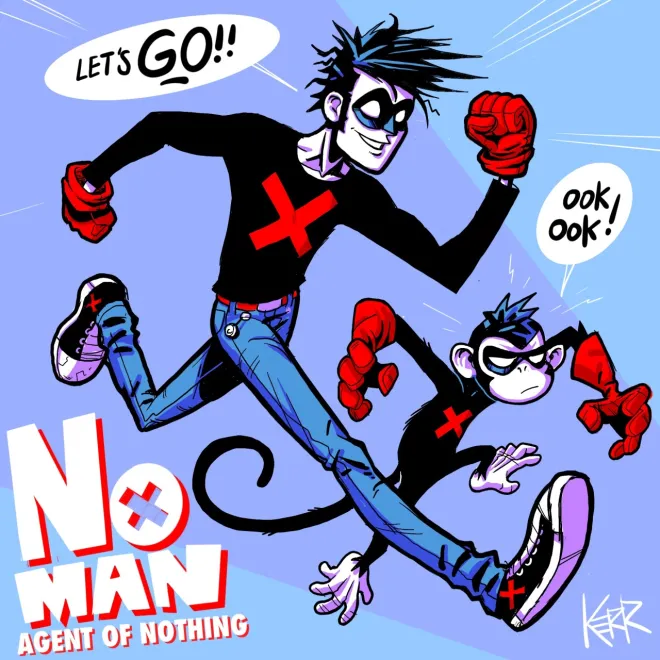
‘Hands up who wants surreal hipster pseudo-superhero zombie occult-detective postmodern
pop-art meta-comics? THAT’S RIGHT, EVERYBODY DOES!’
No-Man has a very light, over the top feel about it, but you can definitely see the seeds of what made the Judge Dredd strip work here. And there’s even a mention of Hewligan’s Haircut – so although you didn’t reference it in your fave 2000 AD strips/creative teams, I guess you’re a Hewlett/Milligan fan as well!?
AK: Hewlett has been a big art hero of mine forever. No-Man is my love letter to that late 80s/early 90s Deadline-style hipster comic scene – which 2000 AD inevitably introduced me to, through Hewlett in Hewligan’s Haircut, Philip Bond in Time Flies, and Brendon McCarthy in Swifty (and Dredd, of course).
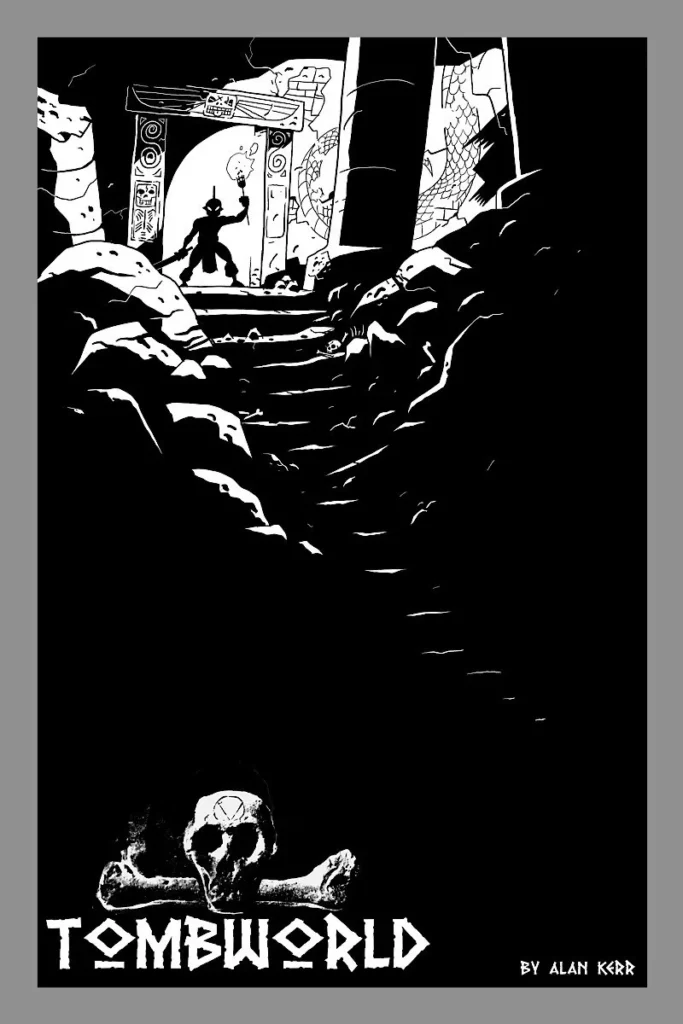
‘A mysterious quest in an endless labyrinth of tombs. Slow-burn, meditative action horror.’
Likewise, Tombworld, although it may start off all serious tomb-raiding stuff, goes off on a great tangent and a equally great ending. And whilst World Without End might come off as out-and-out adventure fantasy, it’s still got the great characterisation and fun we saw in the Dredd strip – so obviously it’s a big part of your work, giving readers the light and the shade, but I think you’d describe yourself as going towards the light?
AK: Probably, although anyone who actually knows me might laugh at that description.
Part of the lightness is the limits of my art style – you can only get so dark in a story with art as cartoony as mine. But it’s also just my natural inclination when I start making anything – I like energy and excitement and momentum. Possibly to balance out my bleak personality.
It’s all typical 2000 AD storytelling, if you look at it – big concepts and trope subversions, all wrapped up in a Trojan horse of exciting, fast paced action/adventure stories. My favourite stories are always clever ones disguised as dumb ones, and I suspect that’s from absorbing 2000 AD as a kid, like Obelix falling into the magic potion.
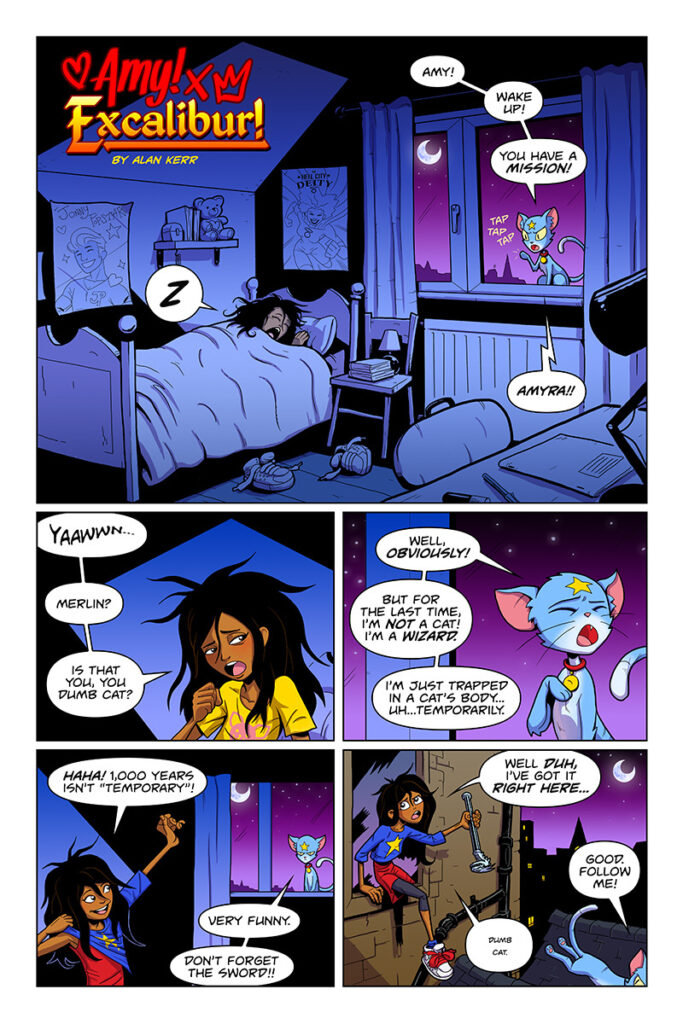
‘Amy accidentally found Excalibur round the back of her Gran’s caravan;
now she fights evil and is technically Fae Queen of Britain’
And it goes on and on with the strips, all of them excellent little things – like Amy Excalibur where Merlin’s trapped in the body of a cat, with young Amy the new holder of the fabled sword after finding Excalibur round the back of her Gran’s caravan… a great little comic.
AK: Thank you. That’s my only strip so far intentionally made for young kids, but it’s still got that 2000 AD subversion of expectations, while still delivering on excitement (I hope).
Skull Hunters returns to the questing and temple raiding sort of adventuring in sharp contrast b&w. Same with Jack Dragon, albeit in colour, a reluctant hero with a demon-busting dragon in his tattoo. Then there’s Jenny Spider Freak Fighter, simple strip, simple job – retro-styling monster action in Freaktown, another fast and furious thing that looks great.
AK: Jack Dragon and Jenny Spider were living in my head for years before I finally found time to get them out. I have whole worlds planned for them. Skull Hunters is, er… not my favourite. I think you can tell I got bored of the idea halfway through! But part of the fun of any anthology is the strip you don’t like, right? Experiments inevitably make failures as well as successes.
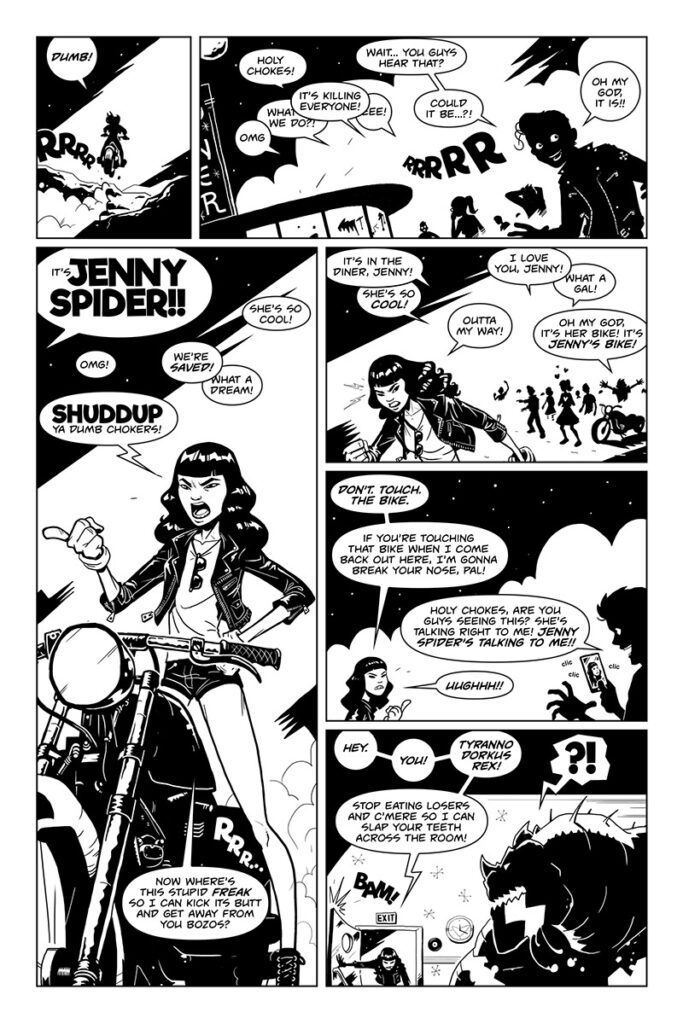
‘She fights freaks. In Freaktown. Action, comedy, horror, mysterious retro styles. Things get weird.’
Honestly, most of these have that 2000 AD Regened feel to them – and I mean that as a high compliment – Regened is a great thing, drawing in new young readers to 2000 AD and comics. Who knows, maybe that’s one way Tharg might be tempted to show off more of your skills?
AK: Who can say? As a dad, the idea appeals to me, but we must trust the wisdom of Tharg.
With your work, it does seem as though you’re perfectly happy working in B&W or colour – any preferences there?
AK: Whatever suits the story. I probably prefer B&W, because it’s faster! But sometimes the idea demands colour, and I have to grudgingly accept. I’m not the greatest colourist, but I can get by.
So, with your own comics, any thoughts on taking them further, plans for more… etc. etc. etc.?
AK: I’m not sure I have much else to say here. I could drone on for hours about esoteric minutiae in my comics, but I’m not convinced anyone would be particularly interested.
I don’t have any plan or real ambitions with any of these strips. I just love making stuff, and telling stories. I hope other people read them, and like them, but I’ll be making them either way.
>
When making your work, can you tell us a little of your process?
AK: Everything I do is digital these days, I really like how loose it allows the early stages to be – so I tend to thumbnail panels straight onto the “final page” to work out my panel layouts, and dialogue spaces etc. Being a writer-artist, I rarely script anything outside of my head, since I already roughly know who’s doing what and what’s going where, but these thumbnails help me catch out problems in the layout that aren’t obvious in my head – especially missing spaces for dialogue, and awkward panel flow.
My thumbnails will just be really sketchy stick figures, so the next stage is working these up into digital “pencils”. This stage starts incredibly rough, and gets refined with no logical process at all, until it’s fairly detailed. I used to go straight to final inks a lot faster, out of impatience to get to the fun stuff, but I’ve found the longer I spend on pencils and the more detailed these are, the better the final outcome.
Then I make a new layer, and do my final inks on this, with colours then on separate layers underneath. I tend to slap on basic colours quickly, and then spend a long time agonising over hue changes to balance out the whole page.
,
My shadows are usually then a multiply level on top, usually all one colour to make the page feel coherent, and give it that cel-shaded look I use. Then, a new layer for highlights, coloured linework, tinkering for hours, weeping over single pixels… all the classic fun of being an artist.
Then I export the art into a vector app, and do all my lettering there. I’m quite proud that Tharg thinks my lettering is good enough for the Prog, despite the original plan being to re-letter the winning page.
One of the nice things about being a writer-artist at this stage is being able to change the dialogue to fit the final art, either to make the space work better, or to suit the characters more. Sometimes they can surprise you.
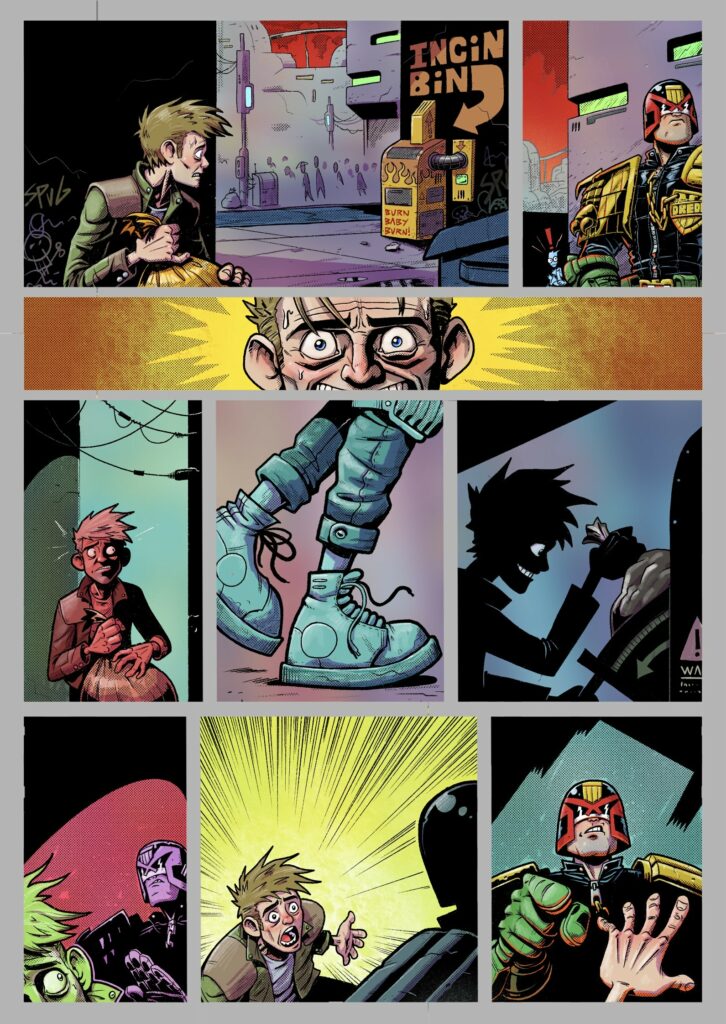
With the Art Stars under your belt, what’s next for you at 2000 AD? Have you plans to pitch to Tharg, our lord and master, for future work – maybe a Future Shock first, maybe something else? And again, would this be as writer & artist, writer, or artist?
AK: I would love to pitch ideas. I have a bag full of them, and more knocking at the door every day. It’s exhausting. The chance to get them out of my head and into the world would be great! How do you email the rosette of Sirius, anyway…?
Carefully?
AK: The absolute dream would be as writer-artist, but as I said earlier, writing feels more realistic given the constraints of my life outside comics… if there is such a thing. But who knows? I have no plans or expectations. I just like making comics, and if anyone reads them, that’s a cool bonus.
Finally, feel free to tell us what’s next for you further afield…
AK: Well, I’m a dad to a toddler and a baby right now, so my utopian idea of future success would be getting a full night’s sleep. Anything else is all gravy.
And parents up and down the country, the world even, are reading this and nodding sagely – or is that exhaustedly?

The end indeed. Many thanks to Alan Kerr there for answering a few questions. And congratulations to him once more for winning the latest – and most difficult – Art Stars. You’ll be able to see his one-page Judge Dredd, The Telltale Incin Bin, in the pages of a future Prog. As for more Art Stars competitions in the future? Well, watch this space as they say.
For more of Alan’s comics and all his social media presence, head to alankerronline.tumblr.com and enjoy!
Now, for the full versions of the process art that Alan sent along to us… roughs, pencils, inks, early colours, finished colours, final published page, complete with Alan’s lettering…
